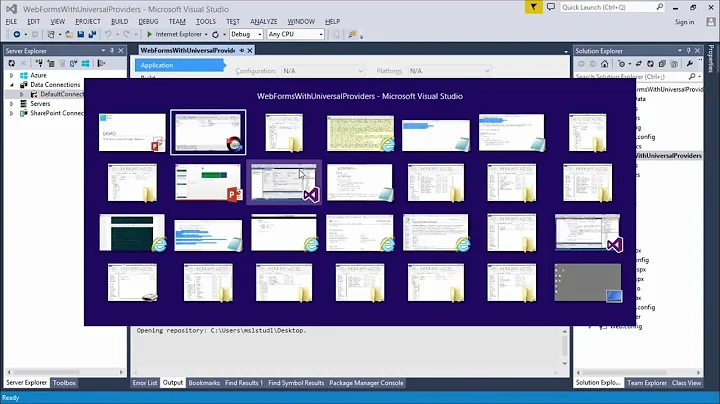ASP.NET membership password expiration
Solution 1
Further to csgero's answer, I found that you don't need to explicitly add an event handler for this event in ASP.Net 2.0 (3.5).
You can simply create the following method in global.asax and it gets wired up for you:
void Application_PostAuthenticateRequest(object sender, EventArgs e)
{
if (this.User.Identity.IsAuthenticated)
{
// get user
MembershipUser user = Membership.GetUser();
// has their password expired?
if (user != null
&& user.LastPasswordChangedDate.Date.AddDays(90) < DateTime.Now.Date
&& !Request.Path.EndsWith("/Account/ChangePassword.aspx"))
{
Server.Transfer("~/ChangePassword.aspx");
}
}
}
Solution 2
You could add an event handler for the HttpApplication.PostAuthenticateRequest event in global.asax and handle the redirection there.
Solution 3
Further to Andrew's answer, I found you need to check that the user is not already on the change password page, or they will never be able to actually change their password, and hence never leave the change password site:
void Application_PostAuthenticateRequest(object sender, EventArgs e)
{
if (this.User.Identity.IsAuthenticated)
{
// get user
MembershipUser user = Membership.GetUser();
// has their password expired?
if (user != null
&& user.LastPasswordChangedDate.AddMinutes(30) < DateTime.Now
&& !Request.Path.EndsWith("/Account/ChangePassword.aspx"))
{
Server.Transfer("~/Account/ChangePassword.aspx");
}
}
}
Solution 4
Just implemented this in about an hour, no need to modify your base page. Heres what you have to do:
Respond to the
LoggingInevent of the membership controlFind the user in the membership database and get
LastPasswordChangedDateUsing a TimeSpan, compare this with the current date and decide if the password was last changed more than the requisite number of days ago. I get this value from web.config
If expired, redirect to the
ChangePasswordscreen
Solution 5
I got here looking for a solution to this but my current technology is ASP.NET MVC. So to help others: you can extend the AuthorizeAttribute, and override OnAuthorization method, like this:
public class ExpiredPasswordAttribute : AuthorizeAttribute
{
public override void OnAuthorization(AuthorizationContext filterContext)
{
IPrincipal user = filterContext.HttpContext.User;
if(user != null && user.Identity.IsAuthenticated)
{
MembershipUser membershipUser = Membership.GetUser();
if (PasswordExpired) // Your logic to check if password is expired...
{
filterContext.HttpContext.Response.Redirect(
string.Format("~/{0}/{1}?{2}", MVC.SGAccount.Name, MVC.SGAccount.ActionNames.ChangePassword,
"reason=expired"));
}
}
base.OnAuthorization(filterContext);
}
}
Note: I use T4MVC to retrieve the Controller and Action names in the code above.
Mark all controllers with this attribute except "AccountController". Doing so no user with an expired password will be able to surf the site.
Here's a post I did on the subject with some bonus points:
Related videos on Youtube
Mahdi Salah
Updated on July 09, 2022Comments
-
 Mahdi Salah almost 2 years
Mahdi Salah almost 2 yearsIs there a way to extend the supported entities in the GenericPathRoute.cs GetRouteData(...) from my custom plugin so that I can add generic url support for my custom entity?
//process URL switch (urlRecord.EntityName.ToLowerInvariant()) { case "product": { data.Values["controller"] = "Catalog"; data.Values["action"] = "Product"; data.Values["productid"] = urlRecord.EntityId; data.Values["SeName"] = urlRecord.Slug; } break; ... case "MyCustomEntity": -
technophile over 15 yearsThat's what I'd do, combined with using the LastPasswordChangedDate property of the Membership Provider to determine when it expires.
-
Brett almost 13 yearsThis will not catch users who have an existing auth ticket ("remember me"). csgero's solution is correct.
-
Andrew over 12 yearsYes, if they are currently authenticated I would say that is not a big issue, unless you make your cookies valid to infinity. Perhaps if you detect that they are already logged in, and expired, then just set the cookie to expire in 20 minutes or so, each time. Then, when they come back, they'll have to change it.
-
 Adam Tuliper over 12 yearsThe issue with checking in PostAuth also is a ton of added system activity for every single request. As long as your tickets expire fairly often there shouldn't be much of an issue, OR you simply run the PostAuth code for +1 day beyond your timeout time. This ensures anyone who hits the site with a valid forms auth ticket gets checked. Then if they don't login at all during that time, the forms auth tickets expire and LogginIn even can be used. After +1 day beyond the ticket expire time you can then remove the PostAuth event. Also you'll want to check upon login
Adam Tuliper over 12 yearsThe issue with checking in PostAuth also is a ton of added system activity for every single request. As long as your tickets expire fairly often there shouldn't be much of an issue, OR you simply run the PostAuth code for +1 day beyond your timeout time. This ensures anyone who hits the site with a valid forms auth ticket gets checked. Then if they don't login at all during that time, the forms auth tickets expire and LogginIn even can be used. After +1 day beyond the ticket expire time you can then remove the PostAuth event. Also you'll want to check upon login -
 Adam Tuliper over 12 yearsand force their ticket to expire at a MAX when their password expires. This prevents those cases of people expiring before their token is up.
Adam Tuliper over 12 yearsand force their ticket to expire at a MAX when their password expires. This prevents those cases of people expiring before their token is up. -
 joshschreuder about 11 yearsPlease note Ben Rethmeier's fix below (stackoverflow.com/a/9879682/324817) so that it is possible to change password on the change password screen.
joshschreuder about 11 yearsPlease note Ben Rethmeier's fix below (stackoverflow.com/a/9879682/324817) so that it is possible to change password on the change password screen. -
Andrew about 11 yearsThanks @shrodes - I've updated my answer to include Ben Rethmeier's fix :o)
-
 philw about 9 yearsThis will not catch users who simply navigate away from the change password screen. They have just authenticated, they're good to go. That is why you have to check each request, inelegant though it is.
philw about 9 yearsThis will not catch users who simply navigate away from the change password screen. They have just authenticated, they're good to go. That is why you have to check each request, inelegant though it is. -
user2379087 over 8 yearsyou handle this event : EngineContext.Current.Resolve<IEventPublisher>() .Publish(new CustomUrlRecordEntityNameRequested(data, urlRecord));








